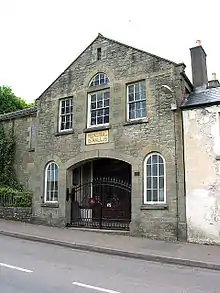Memorial hall
A memorial hall is a hall built to commemorate an individual or group; most commonly those who have died in war. Most are intended for public use and are sometimes described as utilitarian memorials.[1]
In the aftermath of the First World War, many towns and villages looked to commemorate casualties from their communities. Community leaders were expected to organise local committees to construct memorials[2] and halls, for the benefit of the local community, were often seen as appropriate ways in which to honour those who had lost their lives. Most incorporate a plaque or stone, individually naming casualties, although, in some cases, they were built instead of war memorials.[3] Most First World War memorial halls would later go on to be rededicated as memorials to those who also died in the Second World War.
Memorial halls often serve the functions of village halls.
Examples
See also
References
- Machin, Abousnnouga. The Language of War Monuments. Bloomsbury Publishing PLC. p. 88. ISBN 9781623568214.
- King, Alex (1997). Memorials of the Great War in Britain: The Symbolism and Politics of Remembrance. Page 27. Oxford: Berg. ISBN 978-1-85973-988-4.
- "Victorian Heritage Database Report, Lorquon Memorial Hall". Victorian Heritage Database. Retrieved 29 March 2018.
